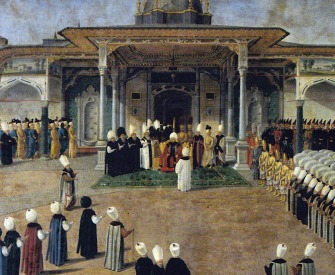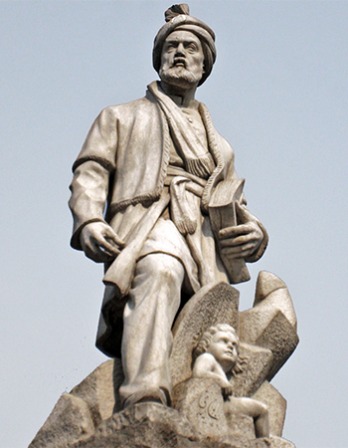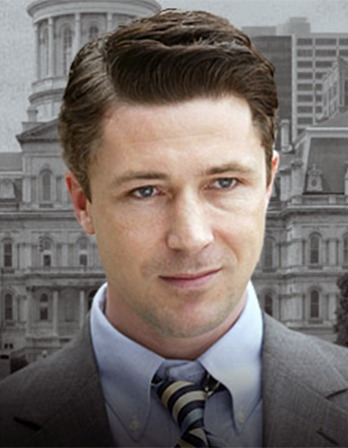Music today is nothing more than the art of performing difficult pieces.
—Voltaire, 1759How Deep Is Your Love?
How Ludwig II’s love for Richard Wagner inspired the world’s greatest work of fan art.
By Alison Kinney

Photochrom print of the front of Neuschwanstein Castle, Bavaria, Germany, c. 1900. Library of Congress.
Act One: In the domain of the Grail. Forest, shady and solemn but not gloomy. Rocky soil. A clearing in the center. On the left a path rises to the castle. The background slopes down in the center to a deep-set forest lake.
—Richard Wagner, Parsifal
No cars are permitted to drive the path that winds up the mountain. In fair weather, as now in late April, buses and horse-drawn carriages convey visitors up the slopes, but conditions of ice and snow close the road to all except foot traffic. Even after the shuttle drop-off point, travelers must walk the final, steepest leg of the journey through a forest of knotty-rooted firs, ferns, mosses, and toadstools. The silence is broken only by birdsong, the rustling of chaffinch or black squirrel through the underbrush, and the tramp of hikers. Like the fool Parsifal, who wanders into the mountains of the Grail knights, I marvel, “I scarcely tread, yet seem already to have come far!”
At last I see the castle, Neuschwanstein, turreted and crenellated, shining white as a swan, perched on the edge of the cliff against the backdrop of the Bavarian Alps. The building appears as though the product of centuries of reconstruction and renovation, right down to the architectural irregularities of the asymmetrical foundation and a red sandstone gatehouse that jars against the white. But Neuschwanstein, the unfinished masterpiece of Ludwig II, king of Bavaria from 1864 to 1886, was a thoroughly modern project, belonging not to medieval history but to neomedieval fairy-tale fantasy, and was built to serve a modern purpose: to manifest, relieve, and exalt Ludwig’s obsession with the works of the composer Richard Wagner. The king was perhaps the world’s greatest opera fan; his Neuschwanstein remains perhaps the world’s greatest work of fan art.
The half-hour English-language tour hustles my group up Neuschwanstein’s narrow servants’ staircase and from room to room. We learn the capsule biography of Ludwig—known as the Dream King, the Swan King, the Kitsch King, the Fairy Tale King, “Mad” King Ludwig—who ascended the throne at the age of eighteen. He became Europe’s most elusive bachelor, withdrew from court life and regal responsibilities, and spent the last two decades of his life building palaces, including Herrenchiemsee, a replica of Versailles, and Linderhof, a candy-box folly inspired by Marie Antoinette’s Petit Trianon.
Ludwig’s family, the House of Wittelsbach, had ruled Bavaria since 1180. They claimed affiliation with the medieval knights of Schwangau and the legendary swan knight Lohengrin, whose image graced the murals of Ludwig’s childhood summer palace, Hohenschwangau. During his adolescence, Ludwig devoured the libretto of Wagner’s opera Lohengrin, in which the beautiful, pure knight appears in a magical swan boat, rescues and marries a damsel in distress, and is forced to renounce all earthly obligation and desire so that he may return to the service of the Holy Grail. At the age of fifteen, Ludwig was granted his earnest desire to hear Wagner’s opera. Shortly afterward, he also heard Wagner’s Tannhäuser, where the title poet’s allegiance to the subterranean realm of desire, Venusberg, sunders him from God and all fit company. A member of Ludwig’s father’s cabinet chronicled that the opera had an “almost demoniacal” effect on the prince: “At the passage when Tannhäuser reenters the Venusberg, Ludwig body was thrown into such convulsions that I was afraid he might have an epileptic seizure.” Ludwig was hooked for life.
Opera fans have their own special ways of abandoning themselves to the objects of their affection. They have been known to hitch themselves to a diva’s carriage and pull it triumphantly through the streets, shower roses onto the stage, sprinkle the ashes of dearly departed fellow fans into orchestra pits. Ludwig’s style was supported by a monarch’s power and magnificence; one of his first acts following his coronation was to summon Wagner to court. “I burn with ardor to behold the creator of the words and music of Lohengrin,” he wrote, sending a ruby ring and a signed photograph of himself as gifts. The king soon funded the premiere of Tristan und Isolde, Wagner’s masterpiece of love, death, and transcendence, which had been composed six years prior and condemned as unstageable. In the days before the premiere, Ludwig suffered from tremors and nervous anticipation; he wept at the dress rehearsal. His mash note to Wagner declared, “You are the world’s miracle; what am I without you?…My love for you, I need not repeat it, will endure forever!” In need of a way to vent his emotions, he pardoned all the participants of the 1848 revolutions that had forced his grandfather Ludwig I to abdicate the Bavarian throne.
In the deepest throes of opera fandom, Ludwig began to build castles as tributes, shrines, refuges, and monuments to his great passion. He envisioned Neuschwanstein during his first year on the throne and began its planning. A few years into his work, he wrote to Wagner, “There will be several cozy, habitable guest rooms with a splendid view of the noble Säuling, the mountains of Tyrol, and far across the plain; you know the revered guest I would like to accommodate there; the location is one of the most beautiful to be found, holy and unapproachable, a worthy temple for the divine friend who has brought salvation and true blessing to the world.”
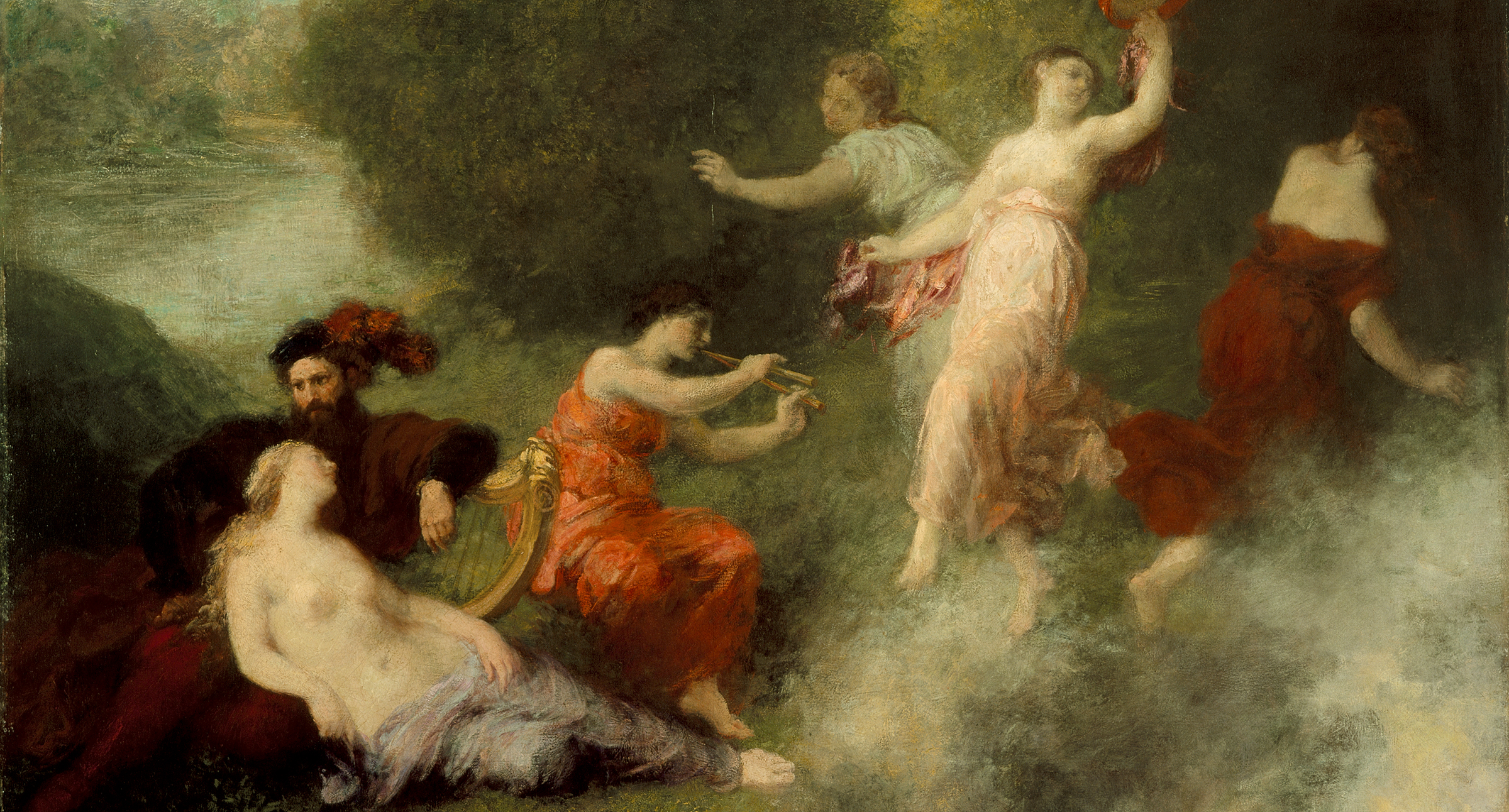
Tannhäuser on the Venusberg, by Henri Fantin-Latour, 1864. © Los Angeles County Museum of Art, gift of Mr. and Mrs. Charles Boyer.
Many building projects exceed original time projections, but Ludwig’s improvements and modifications were particularly inexhaustible. Neuschwanstein was still incomplete when, in 1886, a state commission deposed and incarcerated the king, then forty years old, on the grounds of insanity. Ludwig had managed to spend only 172 nights within the castle walls. One day after his forced removal from Neuschwanstein, he was found dead in Lake Starnberg, near Munich.
As I follow the tour through the castle, I see signs of Ludwig’s fandom glimmering from every surface—from the gilt bronze swan-crested sponge holder in the bedroom to the murals, in semiprecious-jewel tones, depicting the stories Wagner dramatized in Tristan und Isolde, Der Ring des Nibelungen, and Die Meistersinger von Nürnberg. We step from the salon into a cubby-size grotto, complete with tiny waterfall and colored lights—a miniature version of Tannhäuser’s Venusberg. Ludwig’s prodigality of expenditure and taste are immediately apparent to any visitor, but the hows and whys of his fandom remain decipherable only to those of us familiar with the opera references, who feel something more than familiarity. For a fellow obsessive, Ludwig’s fandom is not only comprehensible but communicable—a contagion and a call from one fan to another.
I myself have come to Neuschwanstein in response to that call, like Tannhäuser on pilgrimage, like Parsifal stumbling toward enlightenment. I am not a natural music lover but an earnestly applied one, who, for much of my life, could hear music and sometimes speech only as white noise, whether because I spent the first language-acquiring months of my life malnourished in an institution, where probably no one spoke to me, or because of a congenital ear condition. I approached music with puzzlement, oblivious to whatever it was that got people so excited. Then one day nearly a decade ago, at a Metropolitan Opera matinee performance of Tristan, my head suddenly made sense of the vibrations of the prelude: the violins’ frantic, strained questions and the agony of deferred answers, the time measured in heartbeats and ebbing waves. I had to leave after the first act. I was crying, staggering. I was thirty-three years old, and, finally, I could hear the music. Wagner’s opera taught my brain how to listen. It changed my life.
So I find nothing about Neuschwanstein excessive; I have, after all, a collage of my favorite Wagnerian tenor stuck to my refrigerator. At the end of the tour, in the castle’s gift shop, I buy a white porcelain salt spoon with a swan on it. My long hike downhill ends on the shores of the blue Alpsee, where a coot and a great crested grebe are swimming. I wave my spoon at them like a conductor. Although I have no pretensions to vocal talent, I sing Lohengrin’s aria “Mein lieber Schwan” to the birds. They look at me so expectantly that I’m moved to bust out Isolde’s final love-death aria: “To drown, to founder—unconscious—utmost rapture!”
’Tis completed, the everlasting work:
On the mountain peak stands
The gods’ stronghold,
Superbly soars
The resplendent building!
As in my dreams I desired it,
As my will directed,
Strong and fair It stands on show,
Sublime, superb structure!
—Das Rheingold
Wagner and Ludwig were many things to each other: provocateur and protector, composer and patron, wily old showman and deep-pocketed fanboy. They were men who gazed upon real castles and re-created them in both art and life, first on inked sheets of paper and then in canvas, boards, brick, concrete, and steel. And they shared an extraordinary obsession with opera—an art form that to this day elicits reverence as well as incomprehension and disgust.
The man Ludwig called the “sole source of my delight from my tenderest youth onward, my friend who spoke to my heart as no other did,” was, as the rest of us fans can agree, a terminally broke, self-aggrandizing, self-pitying spendthrift and anti-Semite, fond of dogs and women. Born in 1813 in Leipzig, Richard Wagner won a commemorative-poem contest at grammar school after the sudden collapse and death of a classmate. As a teenager he ran up his first embarrassing debt: a library fine for a music-composition book. Later, to escape his creditors, he made an illegal border crossing under threat of gunfire and through a dung heap. In 1839 he first met Paris’ leading opera composer, the affable Giacomo Meyerbeer. Wagner insisted on reading his latest libretto aloud and solicited introductions to the Jewish composer’s contacts; he then turned around and wrote an anti-Semitic screed denouncing Jewish musicians’ “buzzing” and “gurgling.” He scored a solid job as kapellmeister to the king of Saxony, then was promptly exiled, in 1849, for engaging in earnest but minor bourgeois political agitation. Meanwhile, Wagner composed shimmering, magnificent operas about knights, gods, and poets—strange, challenging harmonies and dramas serving his concept of an “Artwork of the Future” that could comprehend all the artistic forms at his disposal. He was a genius and a jackass in equal measure.

Improvisation No. 29 (The Swan), by Vasily Kandinsky, 1912. © Philadelphia Museum of Art, Louise and Walter Arensberg Collection, 1950.
In 1863, while living near Vienna, Wagner published the Ring poem, the text of his four-opera cycle dramatizing the struggles, passions, grudges, and colossal failures of gods and humans, a work of deadly serious mythic aspiration and much semi-incidental hilarity and charm. His foreword to the poem solicited a royal patron to build a new festival theater, to Wagner’s specifications, to stage the cycle. “Will this prince be found?” he wondered. The following year, on the run again from arrest for debt, he noticed a shop-window portrait of the newly crowned, boyish, splendidly handsome and coiffed king of Bavaria. “A light must show itself,” he mused. “Someone must arise to give me vigorous help now.”
By that time, a teenage Ludwig had already read Wagner’s Ring appeal and was determined to help. Crowned shortly afterward, he sent agents to his hero; Wagner initially mistook them for debt collectors. Finally the connection was made, and when the two men rendezvoused at the royal palace in Munich, it was everything Ludwig had hoped. “If you could only have seen how ashamed I was by his gratitude when I clasped his hand in promise that the great Nibelungen would be completed and performed according to his design!” wrote Ludwig. “That he should bend low over my hand and seem so deeply moved by what was the most natural thing in the world! He remained thus for a long time without speaking, and I felt as though our roles were reversed. I bent down and drew him to my heart, and it seemed that I was swearing an oath always to remain faithful to him.”
Once under the king’s patronage, Wagner did not need convincing to take advantage. He splurged on the perfumes and silks that helped him feel creative. “I must have beauty, splendor, and light!” he wrote. “The world owes me what I need!” Collaborators at last, the two men began planning premieres, new productions of Wagner’s older works, and, of course, the festival theater whose need for funding had brought them together. Wagner’s ambition required two edifices: a festival theater, amphitheater style, intimate, democratic, without class stratifications, with a sunken orchestra pit that wouldn’t interfere with the spectacle onstage, and with plain wooden seats without “luxurious ostentation”; and a conservatory for training singers to handle the relentless demands of range, athleticism, and endurance imposed by Wagner’s vocal lines. They hired renowned architectural theorist Gottfried Semper to commit their dreams to paper.
But the government, press, and public had long been irritated by Ludwig’s spending on Wagner’s debts and productions; by rumors of the former dissident’s political influence on the king; and by Wagner’s domestic life (he’d had a child with Cosima von Bülow, wife of his favorite conductor, whose hiring also rankled the Munich musical establishment). The festival theater was the last straw. In 1865 Ludwig’s ministers forced him to banish Wagner from Munich.
Music sweeps by me as a messenger / Carrying a message that is not for me.
—George Eliot, 1868The loss of his friend was perhaps no less a disaster to Ludwig than the political events of 1866 to 1870: the Austro-Prussian War, the Franco-Prussian War, and Bavaria’s concession of sovereignty to Prussia. (The last brought with it Germany’s criminal code, which outlawed homosexuality in 1871. Bavaria had decriminalized it in 1813, and Ludwig was most likely gay.) These events saw the subordination of Bavaria’s independence to the German state and were a blow to Ludwig’s self-image as absolute ruler and spiritual heir of the Bourbons, to whom his family was distantly connected. Disillusioned and disgusted—even considering abdication of the throne to follow Wagner into exile—Ludwig turned his back on matters of state, family, and court life and threw himself into operatic dreamscapes. His castles rose from the ashes of his life as sovereign and statesman.
Neuschwanstein’s mortar and stone didn’t spring fully formed from Ludwig’s forehead. The plans derived from a combination of the nineteenth-century aristocratic trend of Burgenromantik (castle romanticism), theatrical designs, and Wagner’s opera librettos. Any particular design—the exterior window arches or the carved filigree of spires that canopied his late Gothic walnut bed—might start with an opera cue, then evolve as Ludwig toured other castles, saw a new theatrical set, underwent any vagary of taste or mood. Ludwig listened, loved, and improvised, blending opera, royal history, modern innovations, legend, and sheer whimsy.
A major inspiration was Wartburg Castle in Thuringia, which both Ludwig and Wagner had visited. Wagner had set Tannhäuser in the medieval castle, and Ludwig owned a set of Tannhäuser theatrical models, created by set designer Heinrich Döll and based on Wartburg’s minstrels’ hall. Wagner also used the castle as inspiration for the setting of Lohengrin, which backdrop painter Christian Jank brought to life in his work for the royal theater’s production of the opera. Jank’s backdrops led Ludwig to commission him to paint the original gouaches envisioning Neuschwanstein.
Ludwig also commissioned a Hall of Singers based on Tannhäuser’s minstrel scenes, though he mixed and matched inspirations. The little stage represents a forest scene rather than the pageantry of Tannhäuser, its imagery mimicking the real forest outside, complete with squirrels. But the action in surrounding murals shows that it’s also meant to be the forest surrounding the Grail castle in Parsifal. As in the modern genre of fan fiction, which to some fans offers the delight of repurposing and recombining characters and situations from different works, Ludwig practiced a kind of fan opera, by whose rules any of Wagner’s characters—or Ludwig himself—might wander from one libretto into another.
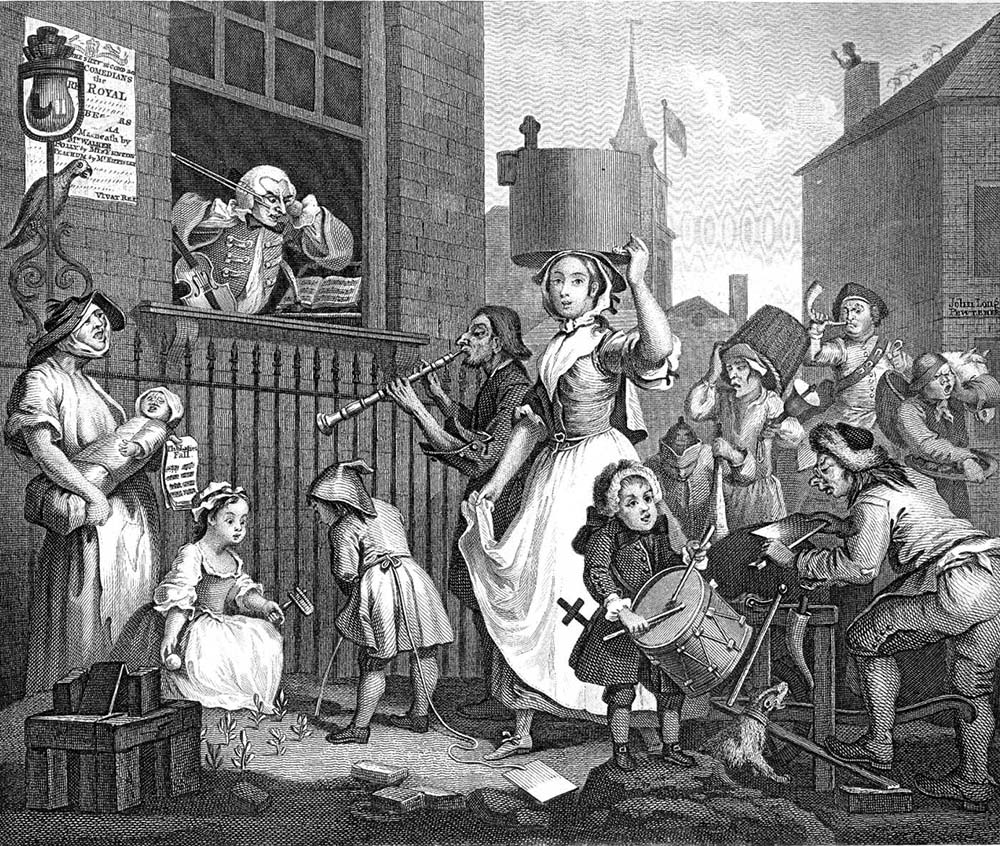
The Enraged Musician, by William Hogarth, 1741. Courtesy of the National Gallery of Art, Washington, Rosenwald Collection.
Ludwig’s fantasies drew the line at authentic conveniences, however. He wanted no part of medieval discomfort, instead choosing to install the newfangled magic of central heating, telephones, running water, and electric lights. (Here, too, he was fastidious to the extreme; in one letter he complained that his moon-shaped night-light was “shining much less brightly than it used to.”) Who would dare tell the scion of the knights of Schwangau that installing flush toilets in his castle desecrated the ideal?
In a far-off land, inaccessible to your steps,
There is a castle by the name of Montsalvat.
A light-filled temple stands within it,
More beautiful than anything on earth.
—Lohengrin
Ludwig’s castles were house temples to honor his opera god; they were not themselves opera houses. But in the 1870s, Ludwig emerged briefly from his building frenzy to rescue Wagner one last, spectacular time—this time by funding an actual theater.
In 1871 Wagner started collecting donations and subscriptions to build his total-immersion festival house in Bayreuth, going against the wishes of Ludwig, who still favored Munich as a site location. Three years later the first Bayreuth Festival—where the Ring cycle was finally set to premiere—was jeopardized by budgetary shortfalls. Ludwig overcame his reservations in order to provide Wagner with a loan of 100,000 talers, representing one-third of the original budget, plus an additional sum to build the composer a family villa. The Ring premiered at Bayreuth, in three cycles, in August 1876. Ludwig was in the audience for the dress rehearsals and the third cycle. As king, patron, and friend, Ludwig had already made opera history; with Bayreuth, he helped realize Wagner’s ideal of Gesamtkunstwerk, a total work of art.
There was another effect Ludwig’s financial backing had on Wagner’s legacy. The terms of the loan to the Bayreuth Festival, not discharged until 1906, mandated that the Munich Court Theater’s musicians and conductors participate in Parsifal. The work held a special status for Wagner, who considered it not an opera but a “stage consecration festival play” celebrating both Bayreuth’s theatrical originality and the sacred mysteries of sacrifice, redemption, and the Holy Grail. In Parsifal, flutes sound out springtime, a men’s chorus sings incantations, horns ring out tones befitting a divine chalice. Parsifal is also Wagner’s most overtly anti-Semitic composition, the one whose obsession with blood purity, the Wandering Jew, and conversion invokes a range of Christian bigotries that were gaining ground in nineteenth-century Europe. It is an outpouring of Wagner’s most histrionic, ideological imagination, mingling glorious music with abhorrent stereotypes.
The terms of the loan meant that for the opera’s 1882 premiere, Wagner was forced to accept Ludwig’s own kapellmeister to conduct the orchestra—Hermann Levi, the son of a rabbi. Wagner’s displeasure was virulent, but Ludwig insisted: Levi, or no Parsifal. In the long history of the composer’s anti-Semitism and later promulgation by the Third Reich, Ludwig’s intervention was a touchstone for Jewish musicians reclaiming Wagner’s work.
It’s also an example of a fan exceeding his mandate, promoting a vision that subserviates his idol. Ludwig’s recognition of Wagner as his master and deity was extreme but not total; he also saw Wagner as his muse, coconspirator, fellow artist. Ludwig exercised the independence of his own devotion.
If one hears bad music, it is one’s duty to drown it by conversation.
—Oscar Wilde, 1890Nowhere at Neuschwanstein is this clearer than in how a plan for a throne room morphed over time into a grand hall decorated with gold leaf, porphyry, and lustrous blue-and-gold mosaics. The design evokes the interior of Montsalvat, the castle in Parsifal where the Holy Grail is protected, as it appeared when the opera went up at Bayreuth. Ludwig took that stage design and imbued it with his own personal influences, taking direction from the Hagia Sophia in Istanbul and the Court Church of All Saints built in Munich by his grandfather—then installed himself in his own fantasy creation as the latest Grail king. Neuschwanstein would never be the Bayreuth theater. The castle was not intended for the performance of Wagnerian opera; it was built as an ideal theater for the performance of being Ludwig II, knight of the swan. It is the art of a fanatic, an unprecedented expression of inspired fandom. It is also Ludwig’s own Gesamtkunstwerk.
But it was never to be completed. By 1886, Ludwig found himself in hard times financially, politically, and personally. He wrote to a minister,
Since deplorable manipulations have depleted the Treasury, and my buildings which are my heart’s desire have come to a standstill, the joy of my life has been taken away, all else is of trifling account…I urge you most earnestly, therefore, to do all you can for the fulfillment of my dearest desire, and to silence the voices of opposition. You would be granting me a new lease of life.
Relief didn’t come. A few months after Ludwig sent the letter came his removal from Neuschwanstein, imprisonment, and mysterious death. The castle was opened to the public seven weeks later. His singular, secluded domain, where he received no strangers and spent only those 172 nights, became a theater for tourists to enact their own fantasies—among them Walt Disney, who many believe was inspired by it when he designed Sleeping Beauty’s and Cinderella’s castles for his Magic Kingdom.
In visiting Neuschwanstein, I enact my own fantasies about Wagner and Ludwig, my urges toward art and devotion. In the gift shop, I am tempted to blow all my cash on a Ludwig bust, Ludwig T-shirt, Ludwig commemorative plate. But I decide, unlike the king, to choose the path of thrift. Sometimes, even in the throes of deepest fandom, we have to say no.
After the tour, on my way to the restroom, an object catches my eye and I pause. It’s a stove designed by architect Julius Hofmann and constructed by Munich stove setter Joseph Xaver Mittermayr for Neuschwanstein’s Lohengrin-themed rooms. It is a tall, ornamented ceramic-tile stove in key lime, with coral, gold, and brown accents. It looks a bit like a tropical cocktail, if such a thing could ever bear carvings that read FIDES, CARITAS, and SPES: faith, charity, and hope. It’s delicious, operatic.
But Ludwig said, “Nein.” He had it put into storage, unused; he chose to install a traditional brown-tiled Bavarian stove instead. It’s that fastidious shudder that I love most at Neuschwanstein, the moment when Ludwig, teetering on the brink of fandom’s abyss, decided that this particular item was too much—was taking the whole Wagner thing too far—and exercised the pleasure of restraint.
